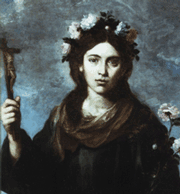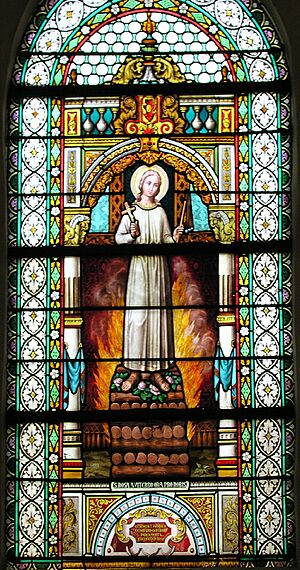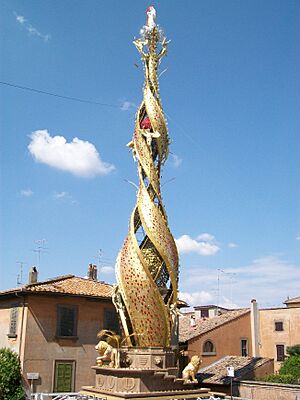Rose of Viterbo facts for kids
Quick facts for kids SaintRose of Viterbo TOSF |
|
|---|---|
 |
|
| Virgin | |
| Born | c. 1233 Viterbo, Papal States |
| Died | 6 March 1251 Viterbo, Papal States |
| Venerated in | Roman Catholic Church |
| Canonized | 1457 by Pope Callistus III |
| Major shrine | Church of St. Rose Viterbo, Italy Saint Rose de Viterbo Catholic Church Longview, Washington |
| Feast | 4 September |
| Attributes | crown of roses, crucifix |
Rose of Viterbo (born around 1233 – died March 6, 1251) was a young woman from Viterbo, a city in Italy. At the time, Viterbo was part of the Papal States, lands ruled by the Pope. Rose was a member of the Third Order of Saint Francis, a group of people who follow the teachings of Saint Francis of Assisi in their daily lives. Even though she lived a short life, she became known for her special gifts, like being able to predict the future and perform miracles. The Catholic Church honors her as a saint.
Her Life Story
We don't have exact dates for everything in Rose's life. Most experts believe she was born around the year 1233.
Rose came from a family that was not rich but was very religious. Even as a young child, she loved to pray and help people who were poor. She often prayed for others to change their ways and become better people.
When Rose was not yet 10 years old, it is said that the Blessed Virgin Mary told her to join the Third Order of St. Francis. She was also told to preach about changing one's life in Viterbo. At this time, Viterbo was under the rule of Frederick II, Holy Roman Emperor, who was in conflict with the Pope.
Rose lived a quiet life of prayer and simple living in her family's home. Sometimes, she would leave her home to encourage people to change their ways. Her mission to preach lasted for about two years.
In January 1250, when Rose was 12, her city of Viterbo was rebelling against the Pope. Rose began speaking out in the streets against Emperor Frederick's control of Viterbo. Because of this, Rose and her family were sent away from the city. They found safety in a nearby town called Soriano nel Cimino. When the Pope's supporters won in Viterbo, Rose and her family were allowed to return home.
On December 5, 1250, Rose reportedly predicted that the emperor would die soon. This prediction came true on December 13. Not long after, she went to another town called Vitorchiano. People there believed a sorceress was causing problems. Rose helped everyone, including the sorceress, to change their beliefs. It is said she did this by standing unharmed in the flames of a burning pyre for three hours.
Rose wanted to join a group of nuns called the Poor Clares in Viterbo. However, she was not allowed to join because her family was poor and could not pay the "dowry" (a payment sometimes required to join a religious order). She accepted this, but she also predicted that she would enter the monastery after her death.
Rose died on March 6, 1251, at her family's home. For a long time, people thought she died from a lung disease called tuberculosis. But in 2010, scientists studied her remains and found that she died from problems related to a rare condition called Pentalogy of Cantrell.
Becoming a Saint

The process to make Rose a saint, called canonization, began in the year she died, 1251. But it wasn't officially completed until 1457. Rose was first buried in a local church. In 1257, Pope Alexander IV ordered her body to be moved to the monastery she had wanted to join. After this, the monastery was renamed in her honor.
Her special day, or feast day, is celebrated on September 4. This date marks when her body was moved to the monastery. In Viterbo and among the Franciscans, this is the main day to celebrate her.
The Machine of Saint Rose
Every year on September 3, the night before Saint Rose's feast day, the people of Viterbo have a special tradition. They carry a huge tower called La Macchina ("the Machine of St. Rose"). This tower is about 28 meters (92 feet) tall, lit up with thousands of lights and candles, and has a statue of Saint Rose on top.
Around 100 volunteers, called "facchini," carry this massive tower for 1,200 meters (about three-quarters of a mile) through the dark, old streets of the city. This tradition started way back on September 4, 1258, when Saint Rose's body was moved. But the "machine" itself first appeared in 1664. The citizens started this tradition to show thanks for surviving a terrible plague that had affected their city for seven years.
Other Connections
- The St. Rose of Viterbo Convent in La Crosse, Wisconsin, is named after her. It is the main house for the Franciscan Sisters of Perpetual Adoration.
- Viterbo University, a Catholic university in La Crosse, Wisconsin, was founded by these same Franciscan Sisters.
See also
- Saint Rose of Viterbo, patron saint archive



